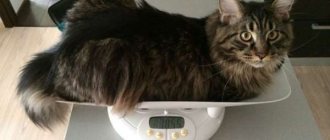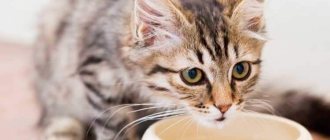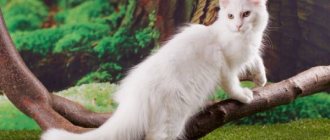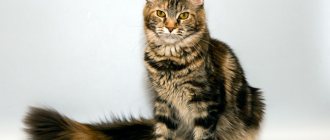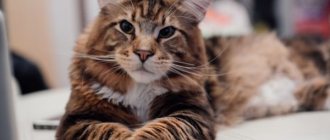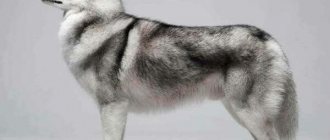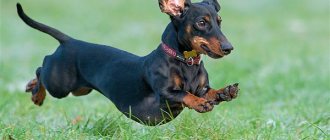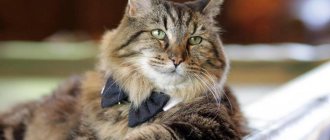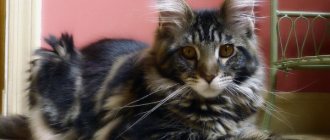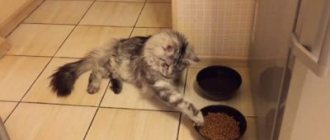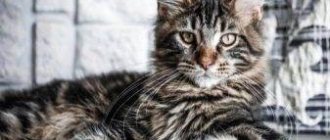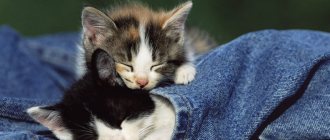Any owner who loves and protects his pet has thought about his health and well-being. Many Maine Coon owners will agree that this animal is not like other cats. In addition to its impressive dimensions, this pet requires increased attention to its health. Already as kittens, pets are born thicker and taller than ordinary cats.
This is why it is important to pay attention to the Maine Coon’s weight and track it month by month. If deviations from the norm are detected, it is necessary to take timely steps to eliminate them, since these furry pets have some developmental features that are important to remember.
Maine Coon Size Standards
Anyone who has ever seen a Maine Coon can imagine its size and weight. So, approximately the weight of an adult male is 9-12.5 kg, and the weight of a girl fluctuates around 4.7-6.7 kg. When reaching 15 months, growth slows down. The length of an adult male varies around 135 cm, and the height at the neck is from 25 to 45 cm. In terms of values, this is comparable to the size of a dog. Cats are built more gracefully, their figures are 3-5 cm smaller. The body, regardless of gender, is dense and stocky. The body is elongated. Representatives of the breed have heavy bones and well-developed muscles. Thanks to developed muscles, the body appears powerful and strong.
The neck is of medium length, thick and strong. There is usually a thick collar around the neck. The chest is wide and powerful. The paws are just as strong and massive.
This breed is the largest among domesticated cats. Despite their weight, cats look even larger due to their fluffy and thick fur. However, it is important to monitor the weight very carefully and not overfeed your pet. This can lead to serious consequences, the most harmless of which is obesity.
The pet must eat properly, healthy food and on a schedule. Then his weight will not go beyond the norm.
Appearance Features
It is worth knowing that at a young age it is quite difficult to notice the difference between animals. Thoroughbreds have similarities to ordinary ones, but they still have unique features. When inspecting, pay attention to:
- Ears. They are noticeably larger than those of ordinary pets, set almost at a right angle to the head, there is no forward bend, like in a Siberian cat. They are wide at the base and then gradually narrow. They end with a tassel - a unique external feature. The kitten can be born with it, more often it grows later, but by a maximum of 3 months there should already be a tassel on its ears. For this reason, it is better to select a pet at this age.
- Head. It is slightly elongated, since the length is slightly greater than the width. All features are clear, and the whisker pads form a “box”, making the muzzle square. The cheekbones protrude noticeably, which is not typical for ordinary domestic kittens.
- Eyes. They are slightly slanted and almond-shaped, unlike the rounded ones of other cats.
- Paws. Firstly, they are quite large even in babies, and secondly, tassels also grow on them - between the claws.
- Tail. This part of the body in purebred animals is long, about 2 times longer than in their domestic relatives. It is worth noting that selling Maine Coons is a profitable business, and there is a high risk of fraud. The breeder can tell that the tassels have not yet grown, the shape of the face sometimes seems similar, but the length of the tail can reveal the truth. Therefore, it is better to cooperate with reliable nurseries, where they will provide you with all the necessary documents.
- Wool. Even in kittens it is of medium length and thick.
- Dimensions. At the age of five weeks, Maine Coons are already comparable in size to a six-month-old ordinary kitten; at 4-5 months they “catch up” with an adult.
- Body type. It should be strong, the chest should be wide, the bones should be massive.
Also, purebred representatives of the breed are much more active and mobile than their ordinary counterparts, they develop faster and switch to food earlier.
To what age do representatives of the breed grow?
Maine Coons grow up to 15 months, and then gain weight up to 3 years. On forums I often write about giant cats weighing 20 kg, but in reality this is unlikely. So far, such indicators have not been recorded at any exhibition. The largest, largest representatives weigh no more than 15 kg; weight above indicates obesity and health problems.
Females are smaller than males, but some females under 2 years of age can be larger than a one-year-old male. Their development is faster, but this is not always the case. If babies, as kittens, receive a lot of vitamins from their mother’s milk, then boys will initially be larger than girls. After a cat gives birth for the first time, she may gain a significant amount of weight, but will then return to her pre-birth form. A slight decrease in weight is possible at the first stage of development.
Feeding kittens with prepared food
Feeding your pet prepared food has many benefits. In particular, it makes it easier to choose the right diet and relieves the owner of the need to prepare food for the cat. However, the following recommendations must be observed:
- The food should be appropriate for the age of the kitten and, if possible, the breed.
- It must be of high quality - no lower than premium class.
- For the first time after arriving in a new home, the kitten should eat the same as in the breeder’s home. If he ate ready-made food, then you need to try to find exactly the same one and feed the baby with it.
- Transfer to another food can begin after the period of adaptation to the new home has been successfully completed. At the same time, you cannot immediately transfer the Maine Coon to a new food; the transition should be carried out gradually.
- You cannot combine feeding with prepared food and natural food. The kitten must eat one or the other.
- Up to 1.5 years of age, the pet can be fed with dry food for kittens; later, it is recommended to switch the Maine Coon to food designed for adult animals.
It is necessary to strictly follow the daily quantity and serving size recommended by the food manufacturer.
How much does an adult Maine Coon weigh?
Cats and cats
Castrated males can reach a weight of 15 kg. This is due to hormonal fluctuations. However, during mating, cats can be very thin, since this process requires a lot of energy and strength from the animal. After time has passed after castration, Maine Coons look very noble and “weighty”, since their hormones no longer fluctuate and they are always in high spirits. Massiveness is achieved due to the long and fluffy body; in males, the length of the body from nose to tail can be more than a meter. Record set: 1 meter 23 cm.
Overweight problems
Despite their good health, feline flexibility and activity, as well as good stamina, Maine Coons are genetically predisposed to a number of diseases. Among them:
- hip dysplasia;
- spinal muscular atrophy;
- cardiomyopathy.
For Maine Coons, extra pounds can increase the risk of these diseases. In addition, excess weight in all cat breeds puts increased stress on the heart and joints and complicates the functioning of the excretory system.
A large and beautiful Maine Coon is a source of pride for its owners. But you shouldn’t chase mythical weight figures for the sake of fashion and to the detriment of health. A reasonable approach to nutrition and care is the key to a long and joyful life for your pet.
Normal weight of a Maine Coon kitten by month from birth to one year
From the moment of birth until full development, the Maine Coon changes greatly in size. In the early stages, boys and girls do not differ much in weight, but the difference appears sharply at a certain stage.
- The initial stage is counted from the moment the kitten is born. It lasts only 4 days after birth, but it is during these days that the future state of the baby’s health is determined. He must receive all the vitamins, so it is important to take care of the mother's health. It is impossible to say exactly how much the baby will grow, since this factor is individual for everyone and depends only on the condition of the kitten after birth.
- This stage lasts much longer than the first - 4 weeks. The individual gains weight steadily and on an ongoing basis. In general, 20-50 g per day. By the end of the month of life, kittens of the same litter equalize in height and strength, underdeveloped kittens are restored to healthy individuals. The weight of a one-month-old kitten can be up to 1 kg, in the second month the maximum weight estimate is 1.5 kg.
- The next stage lasts until seven weeks of age. The obvious difference from the other stages is that there is a transition to solid food. At this stage, a slowdown or a sharp increase in weight is possible - it is difficult to predict, it depends on the individual characteristics of the breed. By the seventh week, this transitional stage ends, and body weight increases again. The kittens will begin to gain weight, because the new diet should contain all the necessary microelements and vitamins.
- Stage four. "After the sucker." This stage lasts until the animal's growth is complete.
| Age | Cat, weight in grams | Cat, weight in grams |
| 7 days | 240 -260 | 240 — 290 |
| 14 days | 320 — 410 | 340 — 420 |
| 1 month | 550 — 740 | 640 – 820 |
| 2 months | 1000 — 1400 | 1100 — 1500 |
| 3 months | 1600 — 2200 | 1800 — 2400 |
| 4 months | 2600 — 3500 | 3000 — 3800 |
| 5 months | 2800 — 4300 | 3200 — 5500 |
| Six months | 3200 — 4500 | 3900 — 6000 |
| 7 months | 3400 — 4900 | 4200 — 6500 |
| 8 months | 3700 — 5200 | 4500 — 6900 |
| 9 months | 4000 — 5400 | 5000- 7000 |
| 10 months | 4100 — 5800 | 5200 — 7700 |
| 11 months | 4200 — 6100 | 5700 — 8000 |
Further growth occurs to the size of an adult male/female. By the 3rd year of life, the pet should gain full weight, which will not change after that.
Kitten development
During its maturation, a growing kitten goes through four stages of growth:
- Neonatal period. This is also the period of the newborn. It usually lasts 4 days. During this time, the daily weight gain of the cat's cubs depends on how easy their mother's birth was.
- Suction period. Lasts 1 month. During this time, kittens, on average, gain from 20 to 50 grams of weight daily.
- Transition period. It begins from the time the cat cubs begin to eat a little on their own and continues until about one and a half to two months (7-8 weeks of life). At this time, the rate of weight gain slows down somewhat.
- After the suckling period. The kittens are weaned from their mother, the cat, and feed completely on their own. They begin to gain weight and height again quite quickly. This stage lasts from approximately one and a half months until the little Maine Coon becomes a full adult.
Cats of this breed mature and gain weight until about the age of three.
They also grow up to the age of 3 years. It is during this period that physiological and psychological maturation occurs, as well as puberty. For about another year or two the cat will continue to “matrate.” Muscle mass will increase, he may gain a little weight, and his chest will expand. At the age of 4–5 years they are active and full of energy.
What affects a kitten's growth
Maine Coons cannot be compared to other kittens from birth. They are much larger and heavier. The minimum weight is one hundred and twenty grams. The body weight and development of a kitten into an adult depends on several factors, both independent of the owner and of care.
The growth rate is influenced by these factors:
- Number of kittens at birth
The weight of kittens greatly depends on the number of representatives of the breed born at the same time. The fewer kittens born at the same time, the greater the weight of each. And vice versa - more kittens, each weighing less. A female can bear a certain number of kittens, determined by nature, and their weight is also determined. However, even if the kittens are weak at first, this problem can be corrected with vitamins and nutrition. In the first days of life, you need to pay special attention to the mother, make her diet more varied and rich in vitamins. This all directly affects the kids.
- Condition of the animal at birth
Weak, wimpy kittens who have problems with intrauterine development gain weight more slowly and do not develop as quickly as their brothers and sisters. There is no need to worry. Over time, if all feeding standards are followed, the babies will become strong and resilient. But sometimes the litter is “rejected” and the kittens are dwarfs from birth.
- Maine Coon breed
If the breed is “pure”, then the kittens will grow faster. This factor is explained by the fact that the gene pool of the breed will be stronger and hereditary traits will appear more clearly against this background. Therefore, such kittens will be larger, stronger and healthier from birth.
- Representative gender
Over time, differences appear not only in weight, but also in growth rate. At 3-4 months, males will be significantly larger than females.
- Mother's weight
The more kittens the mother has, the better her health, the faster the growth of the offspring will be. Therefore, it is important to monitor the mother’s health during pregnancy. She should receive all useful microelements and vitamins.
- Hormonal drugs
The use of medications by a mother cat for medicinal purposes can cause disruption of the animal’s endocrine system, and this has a negative effect on the kittens. During pregnancy, it is better to limit the consumption of foreign drugs to ensure that the offspring is healthy and strong.
- Combination of genotypes
The genes of both parents lead to the creation of unique traits, the formation of a stronger or, conversely, weaker kitten, and this accordingly affects the speed of development of the offspring.
It is important to remember about external components during the development of offspring:
- The place, or rather the cleanliness and hygienic conditions in which young offspring grow;
- Stress, which can be caused by temperature changes, loud noise, other animals that behave aggressively or too loudly - all this affects the condition of the kittens and directly affects their growth;
- The condition of the mother is important; her diet during breastfeeding should be balanced and extremely nutritious.
Colors
Maine Coons have two genetic colors - red (red) and black. The rest are their shades or lightened versions. The documents use a special EMS color coding.
In the photo there is a Maine Coon cat: black color
Maine Coons are divided into several groups based on color: those with a pattern (tabby), without a pattern (solid), tortoiseshell, silver and smoky.
Components of a tabby pattern:
- the letter "M" on the forehead;
- the mirror of the nose and eyes are outlined in dark;
- horizontal stripes on the paws, and small spots on the stomach;
- “necklace” on the chest made of stripes.
Tabby types:
- Classic (marble): stripes are drawn along the spine, there is often a “butterfly” between the shoulder blades, and rounded marks on the sides;
- Spotted: dotted stripes or small spots;
- Brindle: dark stripe on the back, vertical lines along the sides;
- Ticked: an atypical color found in more eastern breeds. The pattern is marked only on the muzzle, the tip of each hair is painted in a dark color.
The color of solids can be: red, red, black, blue, cream, white. Tortoiseshell: torti (cream) or toby (black, brown, red).
In the photo there is a Maine Coon cat: red color
Why is the Maine Coon not gaining weight?
As soon as the owner notices that his pet is underweight, it is necessary to contact a competent specialist. Typically, lack of weight gain can be caused by a number of reasons:
- Your pet's food intake lacks beneficial microelements. It is necessary to contact a specialist for competent help and selection of vitamins. Most likely you will have to get tested;
- The second reason is clear to everyone - the pet is malnourished, but remains just as active. This imbalance leads to weight loss;
- The kitten is under pressure from others and is in a constant state of stress;
- Some problems, such as genetic predisposition, are simply impossible to correct, but if the disease is acquired during life, then it is necessary by all means to protect the next offspring from them.
If kittens are initially small and weak, their development may be slow. They take longer to reach the required size and weight. Larger individuals from birth develop faster. Often small sizes are due to nature.
Sometimes it’s just a matter of chance and small kittens are simply born, and this genetic failure is simply impossible to correct. You cannot give your kitten supplements to increase its growth without the advice of a doctor. All drugs should be prescribed only by a doctor who will explain why and why this particular drug should be used.
They don't like loneliness
Maine Coons always strive for the room where there is a person; without attention, they suffer greatly. They, as a rule, choose one owner and remain devoted to him for life. If your cat chose you out of all the family members, then you are very lucky, but there are disadvantages: he is unlikely to give you privacy in the toilet or shower. The doors in the room you are in should always be open. These animals generally hate loneliness: even if you leave the house for just a couple of hours, the Maine Coon will greet you with violent screams. But cats of this breed are easy to teach dog tricks. Our pet always comes when called and knows how to fetch. Some owners even boast that they taught their pet the “sit” command. It’s better for you to always be close, otherwise they may be offended by you and will never let you caress them again. Therefore, either take it with you always or don’t start it at all.
For what reasons can a Maine Coon lose weight?
Body weight standards are influenced by the amount of food a kitten consumes. If suddenly an individual suddenly begins to lose weight, this indicates the presence of certain health problems that require urgent solutions.
As soon as your pet begins to lose weight, you need to sound the alarm and pay special attention to its diet. Perhaps the animal does not receive all the necessary vitamins and microelements for growth and development.
If the diet remains the same as before, before weight loss, then you need to pay attention to the psychological state of the animal: perhaps it is experiencing stress. If this is the case, then remove the irritants. However, most often the reason is precisely the presence of health problems. Then specialists who understand this problem come to the rescue. They will be able to prescribe competent treatment without harm to the pet.
Useful tips and tricks
The most important task for the owner of a Maine Coon kitten is to create the right diet for him, which will ensure the normal growth and development of the animal. For coons, natural food is preferable as it is most suitable for them. Veterinarians consider poultry, rabbit, and beef to be the most appropriate. Milk can be given to small kittens; it is not suitable for adults.
Now a number of manufacturers offer specialized food for their owners. They are produced keeping in mind the body weight and size of this cat breed. Such food can be combined with natural food. Veterinarians do not have a consensus on what type of feeding should be chosen. Each owner determines this independently for his pet.
What to do if your pet is obese
If your pet is obese, it is first important to determine the cause. Some foods are contraindicated for kittens and adult animals, such as chicken and fish bones, which can damage the esophagus. You should not give your pet raw meat, especially pork. Meat products without heat treatment can become a carrier of infection and worms. Starchy vegetables, such as potatoes, can cause diarrhea, so you shouldn't give them to your pet. Legumes have a negative impact on the digestive tract. Smoked meats, pickles, spicy and fatty foods are harmful to cats. After identifying the cause, it is necessary to develop a diet, but the pet should not be very hungry. It is better to seek a decision from a specialist who will accurately describe the entire menu, taking into account the necessary vitamins and microelements for the pet.
A healthy, large pet is the result of good care and love from the owner. It is important to pay due attention to the cat, then it will delight you for many years.
